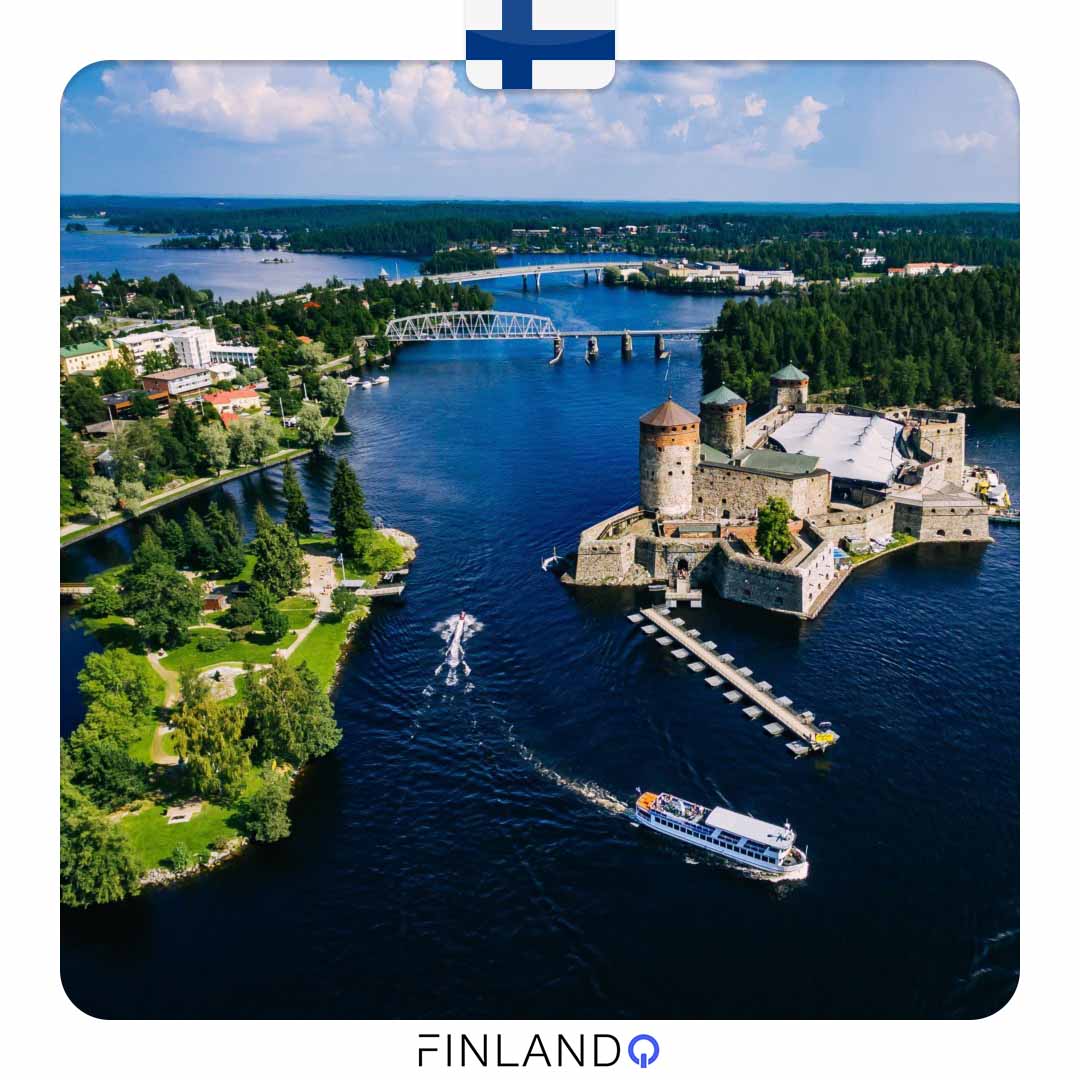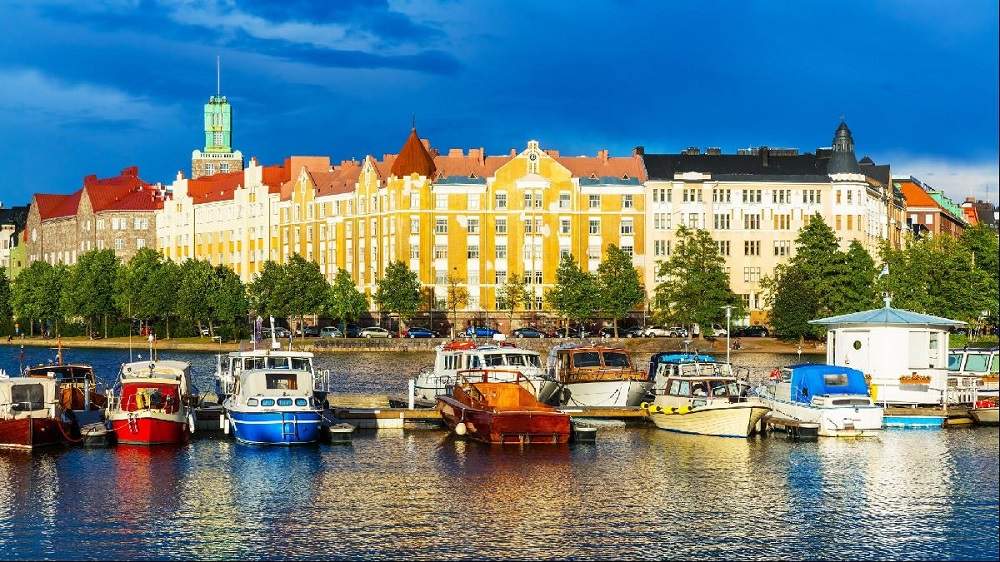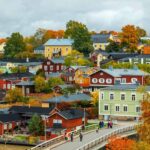Finland is a Northern European country that shares its borders with Sweden, Norway, and Russia. Since joining the European Union in 1995, it has overcome economic downturns. live in Finland can be both thrilling and peaceful. The beautiful Finnish nature, alongside a high quality of life, explains why many people have chosen to travel to this beautiful country for study in recent years.
Among Finland’s tourist attractions are the Northern Lights, which are best visible between September and April. Additionally, the numerous rivers and vast forests create breathtaking landscapes that you may not have witnessed elsewhere in your lifetime. Finland manages universal healthcare well and uses income, assets, and taxes to cover expenses. Therefore, there’s no need to pay high costs for hospital visits and purchasing medicine.
Why choose to live in Finland?
If you have a strong connection to nature, Finland can be an appealing choice for your life. In Finland, there are plenty of lakes and forests, and you’ll always find a special sense of serenity when gazing at the country’s landscapes. Furthermore, the people enjoy a high-quality life, and individual rights and freedoms are well respected. The Finns warmly welcome immigrants and you’ll feel good about being in their country.
If you have young children and plan to live in Finland, it’s essential to register them for kindergarten as soon as possible. All residents of Finland have the right to send their children to public kindergartens until they reach the age to start school. The quality of public kindergartens is very high, but there are also private kindergartens available for a fee.
In general, if you have children, you’re fortunate when moving to Finland. It’s an excellent place for students as they can receive education in some of the world’s best schools and then proceed to universities after completing high school. It’s worth noting that Finnish students spend fewer hours in school compared to students in any other developed country. Finnish students have more time to play, and they aren’t required to take any standardized exams at the end of the school year. The Finnish education system believes that life for children in Finland should be beautiful and peaceful; there’s no need to stress them at a young age.
The Program for International Student Assessment (PISA), conducted by the OECD (Organisation for Economic Co-operation and Development), consistently demonstrates how strong Finnish educational institutions are. It ranks the performance of students in science and mathematics. Finland has consistently scored very high in this three-year assessment.
Why choose to live in Finland? Education and equality: Valuable aspects of life in Finland
You might be surprised, but in Finland, it’s easier to get into medical school than to pursue a master’s degree in education! This reflects the high standards that exist in Finland for teachers. Unlike many countries, Finnish society values teachers as much as medical and legal professionals. The curriculum that teachers must follow is short, and they can do what they want. In other words, the Finnish education system trusts its teachers for instruction.
In public schools, children learn the two official languages of Finland, Finnish and Swedish, plus English. This means that many Finns have a strong command of two foreign languages. They also receive good nutrition, as every child gets a free hot lunch from the school. Life in Finland will undoubtedly be excellent for immigrant children. With the exception of a handful of independent institutions (such as international and religious schools), there are no private schools in Finland. This is partly because equality is a prevailing concept in Finnish life.
Children in Finland start school when they turn seven years old. Education in Finland is compulsory, and the comprehensive school lasts for nine years. Classes have an average of about 20 students. A study by the OECD showed that the difference between the strongest and weakest students in Finland is the smallest in the world. The Finnish educational system aims for equality, so it doesn’t matter where in Finland or in which school you study; the quality of education is the same.
There are international schools in several Finnish cities where instruction is given in English. There are also institutions offering education in French and German. A popular option for immigrant students is the International School of Helsinki. Children can attend this school from the age of 3 and continue until the end of high school. Some other international schools include Turku International School, The English School, and The Oulu International School.

Higher Education in Finland
Life in Finland offers numerous opportunities for higher education provided by universities. Immigrants living in Finland can access university programs in Finnish, Swedish, or English. Degree programs taught in Finnish are usually free of charge, and there are no tuition fees for university education unless you choose to study in English. Helsinki hosts six universities and eight universities of applied sciences. The most famous of them are the Hanken School of Economics, the Academy of Fine Arts, and the Theatre Academy. The University of Helsinki was ranked 96th globally by the QS World University Rankings in 2015/16.
Finding Accommodation in Finland
The internet is always a good starting point for house hunting. Some recommended websites for finding accommodation in Finland are Lumo (in English and Finnish), Etuovi (in English and Finnish), Jokakoti (in Finnish), Oikotie (in Finnish), and Vuokraovi (in English and Finnish). Local Finnish newspapers are another source, but you will need to know Finnish for those.
Buying housing is more common than renting in Finland. Most Finns own their homes, and there are no restrictions on property ownership by foreigners. On average, Finnish households spend around 22% of their income on housing. Rental prices usually do not include electricity or gas, so tenants often pay those separately. One of the advantages of living in Finland is that many apartments and houses have access to saunas. While the winters can be long in Finland, Finns certainly know how to deal with them!
Healthy and Safe Life in Finland
Finland boasts world-class healthcare services provided by Kela, the Social Insurance Institution of Finland. If you work in Finland or live there permanently, Kela has you covered. Kela offers financial aid for students, disability benefits, national pensions, and unemployment security, among other social services. In addition to all these services, Kela is also responsible for healthcare services.
Sauna: A Second Home for Finns
Finland may have just 5.4 million people, but there are 3.3 million saunas in the country! This fact reveals a lot about the Finnish way of life and their priorities. Historically, children were born in saunas, and patients found healing in the hot steam. Nowadays, saunas serve as a place for socializing with friends or relaxing alone. The primary appeal of saunas is their therapeutic heat, believed to relax muscles and alleviate mental stress. In Finland, going to the sauna weekly is common, and if you’re considering life in Finland, sauna will likely become one of your favorite pastimes.
Buses and Trains Are Easily Accessible
Finland is the fifth-largest country in Western Europe, with an extensive network of quality roads connecting it efficiently by train, bus, and highways. Trains connect all major Finnish cities and many rural areas. There are 5,919 kilometers of railway tracks in Finland. In rural areas where there’s no train connection, you’ll often find buses that link to the nearest train station.
Easy Driving in Finland
Finland has excellent roadways, making driving a convenient mode of transportation across the country. However, this might be less true for Helsinki, where finding parking can be challenging. Most locals opt for public transport or cycling instead. From December to February, it’s legally required to have snow tires or tire chains on your car. Don’t forget to always be mindful of reindeer while driving in Finland.
The minimum legal driving age in Finland is 18 years. If you hold a driving license from a European Union or European Economic Area country, you can drive for up to two years after obtaining permanent residence in Finland. During this time, you can apply for a Finnish driving license. Non-EU/EEA driving licenses do not grant you the right to drive vehicles in Finland. You must apply for a Finnish driving license before driving. If you own a car in Finland, you must register it with the Finnish Transport Agency (Trafi).
Getting to Finland by Plane
Finland has 76 airports with paved runways and an additional 72 airports with unpaved runways. Helsinki-Vantaa Airport is the largest airport in Finland by far, with Helsinki having a second airport, Malmi. Finnair is the largest airline in Finland, operating since 1923, making it one of the oldest active airlines in the world.

Interesting Facts About Life in Finland
- In Finland, approximately 83% of people report feeling safe when walking alone at night. The murder rate in Finland is 1.4%, indicating a higher level of safety compared to other countries. You can go out at night without fear, taking a leisurely stroll by the sea.
- The life expectancy for women is 83.5 years and for men, it’s 77.5 years. About 21% of Finland’s population is over 65 years old, with men having a shorter life expectancy due to cardiovascular diseases. The high mortality rate among men is also due to a significant number of deaths related to alcohol consumption.
- The child mortality rate in Finland is 4%, one of the lowest rates in the world. However, this was not always the case. In the 1930s, one out of every ten infants died in their first year, leading the government to provide maternity packages in 1949. These packages included baby supplies like clothing, toys, and blankets. Additionally, a focus on health and medical care helped reduce child mortality rates. Today, maternity clinics offer stress-reducing support and consistent services to all mothers.
- In the past, about 10% of young families with children reported food insecurity, meaning they couldn’t afford groceries despite having access to stores. These difficulties were more prevalent in families with less-educated parents. In 2015 and 2017, Finland implemented a new solution, offering cost-free education to children under 17 years in low-income families.
- Approximately 69% of people between the ages of 15 and 64 are employed, with around 4% of employees working very long hours. 88% of adults aged 25 to 64 have a satisfactory level of education. All students receive an equal education, which is free, and the high quality of classes often leads to most students obtaining a bachelor’s degree. Finland has one of the most comprehensive education systems globally, with their standardized test scores ranking highest among European countries.
- Finland spends less than 7% of its GDP on healthcare. This is one of the lowest rates among European Union members. The government finances 76% of all healthcare costs through taxes, ensuring that every Finnish resident receives free healthcare.
- In 2017, Finland allocated 10 million euros to assist 2,500 immigrants in finding jobs. This effort led to significant progress for immigrants in Finland.
- The average monthly salary in Finland is 3,300 euros. However, nearly half of employed Finns earn less than the average, making around 2,900 euros per month
If you need advice on immigrating to Finland, you can speak with our experts at the FinlandQ group and get the necessary guidance.












